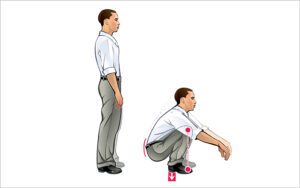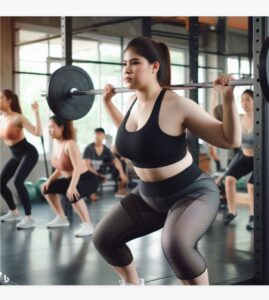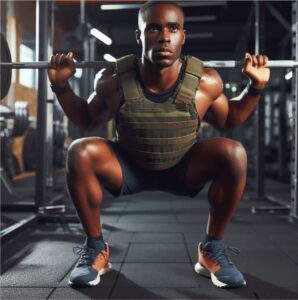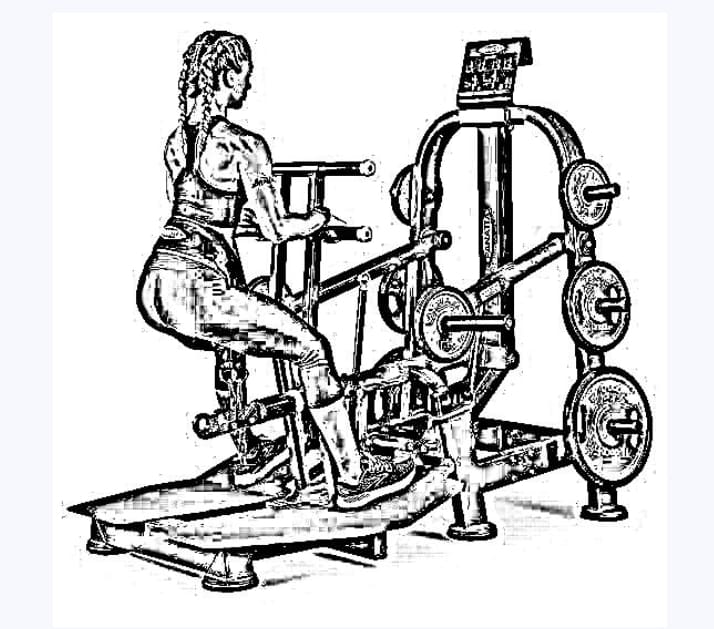
Deep squats, a fundamental lower body exercise, are more than just a gym favorite; they offer a multitude of benefits and advantages that extend beyond mere muscle strengthening.
This particular squat variation, wherein you lower your body as far down as possible, engages various muscle groups and promotes functional movement. Let’s explore the ten proven benefits of deep squats and understand how they contribute to enhancing overall health and fitness.
Before we dive into these 10 deep squats benefits, let’s talk about the exercise itself first.
Understanding Deep Squats
Deep squats involve a full range of motion where you descend until your hips are lower than your knees, maximizing the engagement of muscles in the lower body. This exercise targets the quadriceps, hamstrings, glutes, and core while also requiring stability and flexibility throughout the movement.
How to do deep squats with proper form
To do a deep squat with proper form, follow these steps:
- Stand with your feet shoulder-width apart and your toes pointing slightly outward.
- Hold a weight in front of your chest with both hands, such as a kettlebell or dumbbell.
- Brace your core and lower your body down as if you were sitting in a chair.
- Continue lowering until your thighs are parallel to the ground or as low as you can comfortably go.
- Drive through your heels to stand back up.
Key points for proper form:
- Keep your back straight and your core engaged throughout the entire movement.
- Don’t let your knees cave inward or your heels come off the ground.
- Lower your body until your thighs are parallel to the ground or as low as you can comfortably go.
- Drive through your heels to stand back up.
Common mistakes to avoid:
- Rounding your back
- Caving your knees inward
- Letting your heels come off the ground
- Not lowering your body low enough
- Not driving through your heels to stand back up
If you are unsure about how to do deep squats with proper form, it is a good idea to consult with a qualified personal trainer or strength and conditioning coach.
Now that we have talked about deep squats, let delve into the 10 proven benefits of deep squats and explore how the exercise provides these benefits
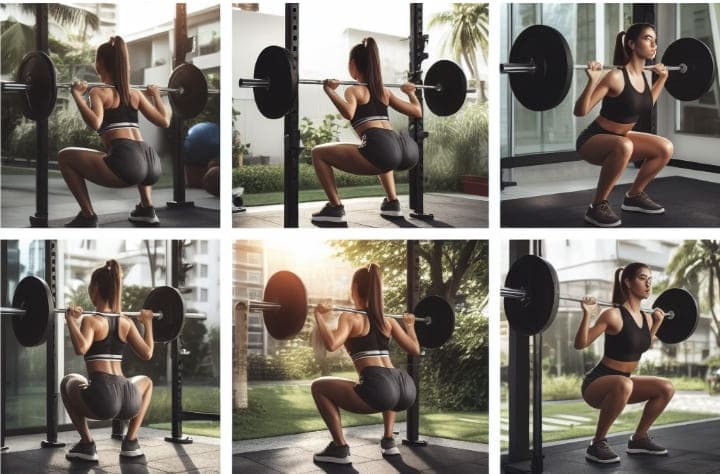
Benefits of Deep Squats
Deep squats offers an array of benefits that impact various aspects of physical health and fitness. Here are ten (10) notable benefits of incorporating deep squats into a workout routine and an explanation on how they provide these advantages:
1. Increased Muscle Strength and Power
Deep squats provide the benefits of increased muscle strength and power through a number of mechanisms:
- Muscle overload: Deep squats require the quadriceps, hamstrings, glutes, and core muscles to work against a load, which helps to stimulate muscle growth.
- Mechanical tension: The front-loaded position of the deep squat places more tension on the quadriceps than other types of squats. This can help to increase quadriceps strength and power.
- Metabolic stress: Deep squats are a compound exercise that works multiple muscle groups. This creates metabolic stress, which can also contribute to muscle growth.
- Neuromuscular activation: Deep squats require the coordination of multiple muscle groups to work together effectively. This can help to improve neuromuscular activation, which can lead to greater muscle strength and power.
- Improved range of motion: Deep squats allow you to squat deeper than other types of squats. This can help to improve the range of motion of the quadriceps, hamstrings, and glutes. A better range of motion can lead to greater muscle strength and power.
- Reduced risk of injury: Strong muscles and joints are less likely to be injured. Deep squats can help to strengthen the muscles and joints of the lower body, which can reduce the risk of injury.
2. Improved core strength and stability
Deep squats provide the benefits of improved core strength and stability through a number of mechanisms:
- Front-loaded position: The front-loaded position of the deep squat forces the core muscles to work hard to maintain balance and stability. This is because the weight of the load is in front of the body, which creates a forward-pulling force.
- Deep squat position: The deep squat position requires the core muscles to contract isometrically to maintain the position. Isometric contractions are very effective for building muscle strength and stability.
- Compound nature: The deep squat is a compound exercise that works multiple muscle groups, including the core muscles. This helps to develop the core muscles and improve their strength and stability.
- Neuromuscular coordination: The deep squat requires the core muscles to work together with the lower body muscles to generate force and power. This helps to improve neuromuscular coordination, which can lead to better core stability.
In addition to these mechanisms, deep squats also provide a number of other benefits that can contribute to improved core strength and stability, such as:
- Increased intra-abdominal pressure: The deep squat position increases intra-abdominal pressure, which helps to stabilize the spine and pelvis.
- Improved posture: Deep squats help to strengthen the core muscles that are responsible for maintaining good posture.
- Reduced risk of injury: A strong and stable core is essential for preventing injuries, especially in the lower back and shoulders. Deep squats can help to strengthen and stabilize the core, which can reduce the risk of injury.
3. Enhanced Mobility and Flexibility
deep squats provide the benefits of enhanced mobility and flexibility through a number of mechanisms:
- Increased range of motion: Deep squats allow you to squat deeper than other types of squats. This can help to improve the range of motion of the quadriceps, hamstrings, glutes, and hips. A better range of motion can lead to greater mobility and flexibility.
- Stretching of the hip flexors: The deep squat position stretches the hip flexors, which are the muscles that connect the thighbone to the pelvis. Tight hip flexors can restrict range of motion and contribute to lower back pain. Deep squats can help to stretch the hip flexors and improve range of motion.
- Improved ankle mobility: The deep squat position requires the ankles to be mobile in order to maintain balance and stability. Deep squats can help to improve ankle mobility and flexibility.
- Increased blood flow: Deep squats increase blood flow to the muscles of the lower body. This can help to improve circulation and flexibility.
4. Improved cardiovascular health
Deep squats provide the benefits of improved cardiovascular health through a number of mechanisms:
- Increased heart rate and blood flow: Deep squats are a dynamic exercise that increases heart rate and blood flow. This increased cardiovascular demand helps to improve the overall health of the heart and cardiovascular system.
- Improved cardiac output: Cardiac output is the amount of blood that the heart pumps in one minute. Deep squats help to improve cardiac output by increasing the strength and efficiency of the heart muscle.
- Increased vascular function: Deep squats help to improve vascular function by dilating blood vessels and increasing blood flow to the muscles. This can help to improve blood pressure and reduce the risk of cardiovascular disease.
- Reduced risk of cardiovascular disease: Cardiovascular disease is the leading cause of death in the world. Deep squats can help to reduce the risk of cardiovascular disease by improving cardiovascular health and reducing risk factors such as high blood pressure, high cholesterol, and obesity.

5. Increased explosive power and athletic performance
Deep squats provide the benefits of increased explosive power and athletic performance through a number of mechanisms:
- Compound exercise: Deep squats are a compound exercise, which means that they work multiple muscle groups at the same time. This type of exercise is very effective for building explosive power.
- Neuromuscular coordination: Deep squats require the coordination of multiple muscle groups to work together effectively. This type of training helps to develop the neuromuscular coordination necessary for explosive movements.
- Increased muscle strength: Deep squats help to increase muscle strength in the lower body, which is essential for explosive movements.
- Increased power output: Deep squats help to increase power output, which is the ability to generate force quickly. Power is essential for many athletic activities, such as sprinting, jumping, and throwing.
6. Increased bone density
Deep squats provide the benefits of increased bone density through a number of mechanisms:
- Mechanical loading: When you do a deep squat, your bones are subjected to compression forces. This type of force stimulates bone remodeling and helps to increase bone density.
- Muscle contraction: When you do a deep squat, your muscles of the lower body contract isometrically. This type of contraction generates compressive forces on the bones, which also stimulates bone remodeling.
- Hormonal response: Deep squats trigger the release of hormones, such as testosterone and growth hormone, which promote bone growth. Testosterone and growth hormone are known to be important for bone health and can help to increase bone density.
7. Improves balance and Co-ordination
Deep squats are instrumental in improving balance and coordination due to the extensive engagement of various muscle groups and the demand for stability throughout the movement. As individuals perform deep squats, the exercise challenges balance by necessitating controlled movements and an upright posture.
The intricate nature of deep squats involves muscle groups working cohesively to maintain balance and stability during the squatting motion. The continuous practice of this exercise strengthens the stabilizer muscles and encourages a heightened sense of body awareness.
This, in turn, leads to improved balance and coordination as individuals learn to control their body’s movements with more precision. Furthermore, the focus on proper form during deep squats aids in refining neuromuscular coordination, enhancing the synchronization of muscle movements, and ultimately benefiting overall balance and coordination.
8. Improved functional fitness
Deep squats significantly contribute to improved functional fitness due to their multifaceted impact on the body’s mobility, strength, and overall functionality. Here’s how deep squats enhance functional fitness:
- Improved strength: Deep squats work multiple muscle groups in the lower body, including the quadriceps, hamstrings, glutes, and core. This makes them a great exercise for building overall strength.
- Increased power: Deep squats require the muscles to generate force quickly. This is important for many functional activities, such as sprinting, jumping, and throwing.
- Enhanced mobility: Deep squats require a good range of motion in the hips, knees, and ankles. This can help to improve overall mobility and reduce the risk of injury.
- Improved balance and coordination: Deep squats require the body to maintain balance and coordination throughout the movement. This can help to improve overall athletic performance and reduce the risk of falls.
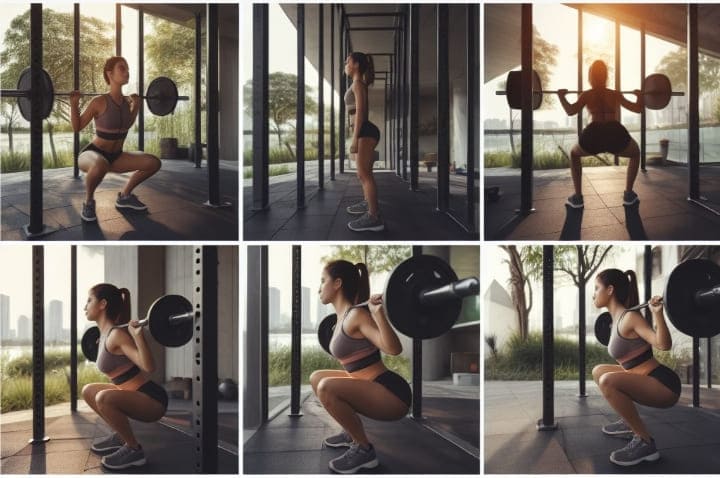
In addition to these benefits, deep squats are also a relatively low-impact exercise, which means that they are less likely to cause injuries than other types of exercises. This makes them a good option for people of all ages and fitness levels.
Here are some examples of how deep squats can improve functional fitness:
- Lifting heavy objects: Deep squats help to strengthen the muscles that are used to lift heavy objects, such as groceries, furniture, and children.
- Running and jumping: Deep squats help to develop the power and mobility needed for running and jumping.
- Playing sports: Deep squats can help to improve athletic performance in a variety of sports, such as basketball, football, and soccer.
- Preventing injuries: Deep squats can help to strengthen the muscles and improve the range of motion in the lower body, which can help to reduce the risk of injuries.
9. Calorie Burning and Weight Management
Deep squats provide the benefits of calorie burning and weight management in a number of ways:
- Increased energy expenditure: Deep squats are a compound exercise that works multiple muscle groups in the lower body. Compound exercises are more efficient at burning calories than isolation exercises, which only work one muscle group at a time.
- Elevated metabolic rate: Deep squats can elevate your metabolic rate (EER) for several hours after exercise. This means that your body will continue to burn calories even after you have finished squatting.
- Reduced muscle mass loss: Deep squats help to preserve and build muscle mass. Muscle mass is important for calorie burning and weight management because it helps to boost your EER.
- Improved body composition: Deep squats can help to improve your body composition by reducing body fat and increasing muscle mass. A good body composition is important for overall health and well-being.
10. Reduced risk of injury
Deep squats provide the benefits of reduced risk of injury in a number of ways:
- Strengthened muscles and joints: Deep squats strengthen the muscles and joints of the lower body, including the quadriceps, hamstrings, glutes, knees, and ankles. Strong muscles and joints are less likely to be injured.
- Improved range of motion: Deep squats improve the range of motion in the hips, knees, and ankles. Increased range of motion can help to reduce the risk of injury by making the joints less susceptible to strains and sprains.
- Better balance and coordination: Deep squats improve balance and coordination. Better balance and coordination can help to reduce the risk of falls and other accidents.
- Reduced muscle imbalances: Deep squats work multiple muscle groups in the lower body. This can help to reduce muscle imbalances, which can also reduce the risk of injury.
Here are some specific examples of how deep squats can help to reduce the risk of injury:
- Knee injuries: Deep squats strengthen the quadriceps and hamstrings, which are the two main muscle groups that support the knee joint. Strong quadriceps and hamstrings can help to reduce the risk of knee injuries, such as anterior cruciate ligament (ACL) tears and meniscus tears.
- Ankle injuries: Deep squats strengthen the muscles around the ankle joint, which can help to reduce the risk of ankle injuries, such as sprains and fractures.
- Back injuries: Deep squats strengthen the core muscles, which are important for supporting the spine. Strong core muscles can help to reduce the risk of back injuries, such as herniated discs and muscle strains.
The optimal frequency for doing deep squats for maximum benefits depends on a number of factors, including your fitness level, goals, and experience. However, a good general rule of thumb is to perform deep squats 2-3 times per week. This will allow you to recover between workouts and make progress towards your goals.
If you are new to deep squats, you may want to start with a lower frequency, such as once per week. As you get stronger and more experienced, you can gradually increase the frequency to 2-3 times per week.
If you are training for a specific event, such as a powerlifting competition or a marathon, you may need to perform deep squats more frequently. However, it is important to listen to your body and take rest days when needed.
In conclusion, deep squats offer numerous benefits for your body and mind. From increased muscle strength and power to improved mobility and flexibility, deep squats are a versatile exercise that can enhance your overall fitness and well-being. By incorporating deep squats into your workout routine, you can reap these benefits and enjoy a healthier, stronger, and more functional body.
Related Posts
Reference:
- https://www.hingehealth.com/resources/articles/benefits-of-deep-squat/
- https://greatist.com/fitness/should-i-squat-deep
- https://www.menshealth.com/fitness/a32730569/what-are-deep-squats/
- https://www.healthline.com/health/fitness/deep-squat
- https://www.inspiremobilept.com/post/the-benefits-of-deep-squats-for-improving-diaphragmatic-breathing
- https://www.americansportandfitness.com/blogs/fitness-blog/the-top-10-benefits-of-jump-squats
- https://www.semanticscholar.org/paper/120a720ada6aae7cab782c6f428c7b0756021bec
- https://www.semanticscholar.org/paper/c44b32a7cbd3946bd6f5a94075a935a60ab594be
- https://www.semanticscholar.org/paper/4991d97aff328f8decb20a497e75fe82f22fc0c7
- https://arxiv.org/abs/2308.02420
- https://www.semanticscholar.org/paper/ee6c4ddadb3fe0b84c4fe89906b30cccd8f099ca
- https://www.ncbi.nlm.nih.gov/pmc/articles/PMC8854721/







